*NURSING > QUESTIONS & ANSWERS > NCLEX-PN TEST BANK (2021/2022) Questions, Answers plus Rationale | (100% Guaranteed Pass) (All)
NCLEX-PN TEST BANK (2021/2022) Questions, Answers plus Rationale | (100% Guaranteed Pass)
Document Content and Description Below
Table Of Contents Introduction. . . . . . . . . . . . . . . . . . . . . . . . . . . . . . . . . . . . . . . . . . . . . . . . . . . . . . . . . . . . vii Chapter 1: The NCLEX-PN® Examination Unit ... 1: The NCLEX-PN® Examination. . . . . . . . . . . . . . . . . . . . . . . . . . . . . . . . . . . . . . . . 3 Chapter 2: Kaplan’s Review for the NCLEX-PN® Examination Unit 1: Kaplan’s NCLEX-PN® Course Materials . . . . . . . . . . . . . . . . . . . . . . . . . . . . . . . 11 Unit 2: How to Use Kaplan’s NCLEX-PN® Review Course. . . . . . . . . . . . . . . . . . . . . . . 13 Unit 3: Kaplan’s PN Decision Tree®. . . . . . . . . . . . . . . . . . . . . . . . . . . . . . . . . . . . . . . . . 19 Unit 4: Guide for Test-Takers Repeating the NCLEX-PN® Examination. . . . . . . . . . . . 21 Chapter 3: Safe and Effective Care Environment Unit 1: Coordination of Care . . . . . . . . . . . . . . . . . . . . . . . . . . . . . . . . . . . . . . . . . . . . . 33 Unit 2: Safety and Infection Control . . . . . . . . . . . . . . . . . . . . . . . . . . . . . . . . . . . . . . . 53 Chapter 4: Health Promotion and Maintenance Unit 1: Growth and Development. . . . . . . . . . . . . . . . . . . . . . . . . . . . . . . . . . . . . . . . . . 83 Unit 2: Childbearing—Normal . . . . . . . . . . . . . . . . . . . . . . . . . . . . . . . . . . . . . . . . . . . . 101 Unit 3: Childbearing—Maternal Complications . . . . . . . . . . . . . . . . . . . . . . . . . . . . . . 117 Unit 4: Childbearing—Neonatal Normal. . . . . . . . . . . . . . . . . . . . . . . . . . . . . . . . . . . . 131 Unit 5: Neonatal Complications . . . . . . . . . . . . . . . . . . . . . . . . . . . . . . . . . . . . . . . . . . 139 Unit 6: Reproduction . . . . . . . . . . . . . . . . . . . . . . . . . . . . . . . . . . . . . . . . . . . . . . . . . . . 145 Unit 7: Prevention and Early Detection of Disease . . . . . . . . . . . . . . . . . . . . . . . . . . . 153 Chapter 5: Physiological Integrity 1: Basic Care and Comfort Unit 1: Mobility and Immobility . . . . . . . . . . . . . . . . . . . . . . . . . . . . . . . . . . . . . . . . . . 185 Unit 2: Conditions Limiting Mobility . . . . . . . . . . . . . . . . . . . . . . . . . . . . . . . . . . . . . . 195 Unit 3: Interventions to Promote Comfort. . . . . . . . . . . . . . . . . . . . . . . . . . . . . . . . . . 215 Unit 4: Musculoskeletal Trauma . . . . . . . . . . . . . . . . . . . . . . . . . . . . . . . . . . . . . . . . . . 219 Unit 5: Rest and Sleep Disturbances . . . . . . . . . . . . . . . . . . . . . . . . . . . . . . . . . . . . . . 231 Unit 6: Nutrition . . . . . . . . . . . . . . . . . . . . . . . . . . . . . . . . . . . . . . . . . . . . . . . . . . . . . . 241 Unit 7: Elimination. . . . . . . . . . . . . . . . . . . . . . . . . . . . . . . . . . . . . . . . . . . . . . . . . . . . . 259 Chapter 6: Psychosocial Integrity Unit 1: Coping and Adaptation. . . . . . . . . . . . . . . . . . . . . . . . . . . . . . . . . . . . . . . . . . . 277 Unit 2: Psychosocial Adaptation. . . . . . . . . . . . . . . . . . . . . . . . . . . . . . . . . . . . . . . . . . 299 Unit 3: Psychopathology . . . . . . . . . . . . . . . . . . . . . . . . . . . . . . . . . . . . . . . . . . . . . . . . 301 Unit 4: Chemical Dependency. . . . . . . . . . . . . . . . . . . . . . . . . . . . . . . . . . . . . . . . . . . . 313 Unit 5: Abuse and Neglect . . . . . . . . . . . . . . . . . . . . . . . . . . . . . . . . . . . . . . . . . . . . . . 321 Chapter 7: Physiological Integrity 2: Physiological Adaptation Unit 1: Medical Emergencies . . . . . . . . . . . . . . . . . . . . . . . . . . . . . . . . . . . . . . . . . . . . 327 Unit 2: Fluid and Electrolyte Imbalances . . . . . . . . . . . . . . . . . . . . . . . . . . . . . . . . . . . 355 Unit 3: Alterations in Body Systems. . . . . . . . . . . . . . . . . . . . . . . . . . . . . . . . . . . . . . . 367 Unit 4: Cancer . . . . . . . . . . . . . . . . . . . . . . . . . . . . . . . . . . . . . . . . . . . . . . . . . . . . . . . . 381 Chapter 8: Physiological Integrity 3: Reduction of Risk Potential Unit 1: Sensory and Perceptual Alterations . . . . . . . . . . . . . . . . . . . . . . . . . . . . . . . . 393 Unit 2: Alterations in Body Systems. . . . . . . . . . . . . . . . . . . . . . . . . . . . . . . . . . . . . . . 409 Unit 3: Perioperative Care . . . . . . . . . . . . . . . . . . . . . . . . . . . . . . . . . . . . . . . . . . . . . . 441 Unit 4: Diagnostic Tests . . . . . . . . . . . . . . . . . . . . . . . . . . . . . . . . . . . . . . . . . . . . . . . . 447 Unit 5: Therapeutic Procedures . . . . . . . . . . . . . . . . . . . . . . . . . . . . . . . . . . . . . . . . . . 461 Chapter 9: Physiological Integrity 4: Pharmacological Therapies Unit 1: Blood Component Therapy . . . . . . . . . . . . . . . . . . . . . . . . . . . . . . . . . . . . . . . 475 Unit 2: Intravenous Therapy . . . . . . . . . . . . . . . . . . . . . . . . . . . . . . . . . . . . . . . . . . . . . 477 Unit 3: Medications . . . . . . . . . . . . . . . . . . . . . . . . . . . . . . . . . . . . . . . . . . . . . . . . . . . . 481 Unit 4: Adverse Effects of Medications . . . . . . . . . . . . . . . . . . . . . . . . . . . . . . . . . . . . 573 Introduction Welcome! By using Kaplan Nursing resources, you’ve taken an important step toward passing the National Council Licensure Examination for Practical Nurses (NCLEX-PN®). Our many years of experience indicate that your success on the NCLEX-PN® examination is keyed to two specific factors: your educational background and your exam preparation. The amount and intensity of study you devote will bring about the greatest benefits from these resources. The best results come to those who actively participate in exam preparation. We will show you how the NCLEX-PN® examination works, what you do and don’t need to know, and the smartest way to take the NCLEX-PN® examination. We provide you with data to help you analyze your practice performance and determine where you need to make improvements. We will give you all the help, advice, and encouragement we can—but only you can do the work. Get to know all the benefits that Kaplan Nursing has to offer so you can make the most of your study time. After you complete your resources and take the NCLEX-PN® examination, please tell us how you did. Kaplan’s Research and Curriculum Development Team works hard to ensure that our course materials employ the most effective and innovative teaching methods. In order to evolve and improve, we need your help. Please take a few moments to share your thoughts on how the materials helped you. Thank you in advance for choosing Kaplan for your studies. KAPLAN 750 Third Avenue, New York, NY 10017 Attn: NCLEX Curriculum [email protected] (kaptest.com) [email protected] (nursing.kaplan.com) Our best wishes for an interesting and satisfying nursing career. *NCLEX is a trademark of N.C.S.B.N., Inc. Please note: All Kaplan lectures, web content, and printed and electronic media are the property of Kaplan Nursing and are copyrighted under law. Chapter 1 THE NCLEX-PN® EXAMINATION Units 1. The NCLEX-PN® Examination Have you talked to LPN/LVNs about their experiences taking the NCLEX-PN® examination? If so, they probably told you it was unlike any nursing test they have ever taken. How can that be? Let’s talk in detail about the NCLEX-PN® examination. NCLEX-PN® stands for National Council Licensure Examination for Practical Nurses and is prepared by the National Council of State Boards of Nursing (NCSBN). The purpose of the exam is to determine if you are safe to begin practice as an entry-level practical/vocational nurse. The NCLEX-PN® examination is a test of minimum competency, and is based on the required knowledge and behavior for the entry-level practice of practical/vocational nursing. This exam tests not only your knowledge, but also your ability to make decisions. The NCLEX-PN® examination is a computer adaptive test, which means each test is assembled interactively based on the accuracy of the candidate’s responses to the questions. This ensures that the question you are answering will not be “too hard” or “too easy” for your skill level. The first question will be near the level of minimum competency (also referred to as the passing line). If you answer the question correctly, the next question will be slightly higher in critical thinking. If you miss the question, the next question will be slightly lower. As you answer questions, the computer is able to calculate your level of competence, as well as select questions that represent all areas of practical/vocational nursing as defined by the NCLEX-PN® test plan. ▶ TAKING THE EXAM You have a maximum of 5 hours to complete the exam, which includes the beginning tutorial, a break reminder after the first two hours of testing, a break reminder after an additional 90 minutes of testing, and any additional breaks you may take. There is no time limit for each question. The NCLEX-PN® examination is a variable-length adaptive test, which means that your test will be anywhere from 85 questions to 205 questions. Of the first 85 questions, 25 are experimental items that are not scored. Your test will end when the computer has determined your ability and you have taken at least 85 questions, or when you have reached the maximum testing time of 5 hours, or when you have answered 205 questions. THE NCLEX-PN® EXAMINATION Unit 1 3 ▶ WHAT BEHAVIORS DOES THE NCLEX- WHAT BEHAVIORS DOES THE NCLEX-PN® EXAMINATION TEST? The NCLEX-PN® exam does not want to test your body of nursing knowledge; it assumes you have a body of knowledge because you have graduated from nursing school. Likewise, it does not want to test your understanding of the material; it assumes you understand the nursing knowledge you learned in nursing school. So what does this exam test? The NCLEX-PN® exam primarily tests your nursing judgment and discretion. It tests your ability to think critically and solve problems. The test writers recognize that as a beginning practitioner, you will be managing nursing assistants to provide care to a group of clients. As a member of the nursing team, you are expected to make safe and competent judgments about client care. ▶ CRITICAL THINKING AND CLINICAL JUDGMENT What does the term critical thinking mean? Critical thinking is problem solving that involves thinking creatively. Using clinical judgment, you successfully solve problems every day in the clinical area. You are probably comfortable with this concept when actually caring for clients. Although you’ve had lots of practice critically thinking in the clinical area, you may have had less practice thinking critically and using clinical judgment on test questions. Why is that? During nursing school, you take exams developed by nursing faculty to test a specific body of content. Many of these questions are at the knowledge level, which involves recognition and recall of ideas or material that you read in your nursing textbooks and discussed in class. This is the most basic level of testing. In nursing school, you are also given test questions written at the comprehension level. These questions require you to understand the meaning of the material. If you are answering minimum competency questions on the NCLEX-PN® exam, you will not see many comprehension-level questions. The test writers assume you know and understand the facts you learned in nursing school. Minimum competency questions on the NCLEX-PN® exam are written at the application and/or analysis level. Remember, the exam tests your ability to make safe judgments about client care. Your ability to solve problems is not tested with knowledge- or comprehension-level questions. Application involves taking the facts that you know and using them to make a nursing judgment. You must be able to answer questions at the application level to prove your competence on the NCLEX-PN® exam. [Show More]
Last updated: 1 year ago
Preview 1 out of 86 pages
Instant download

Buy this document to get the full access instantly
Instant Download Access after purchase
Add to cartInstant download
Reviews( 0 )
Document information
Connected school, study & course
About the document
Uploaded On
Nov 09, 2022
Number of pages
86
Written in
Additional information
This document has been written for:
Uploaded
Nov 09, 2022
Downloads
0
Views
98

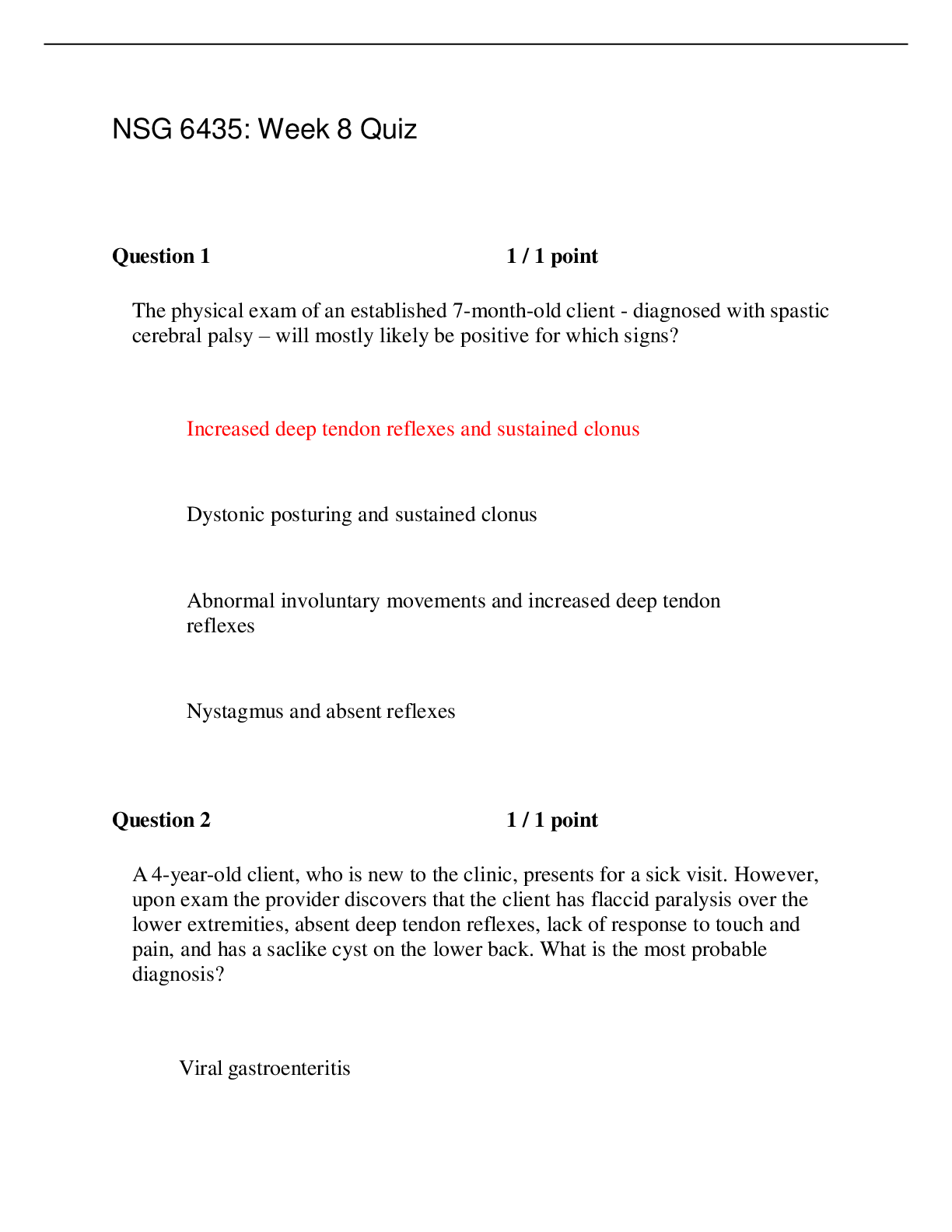

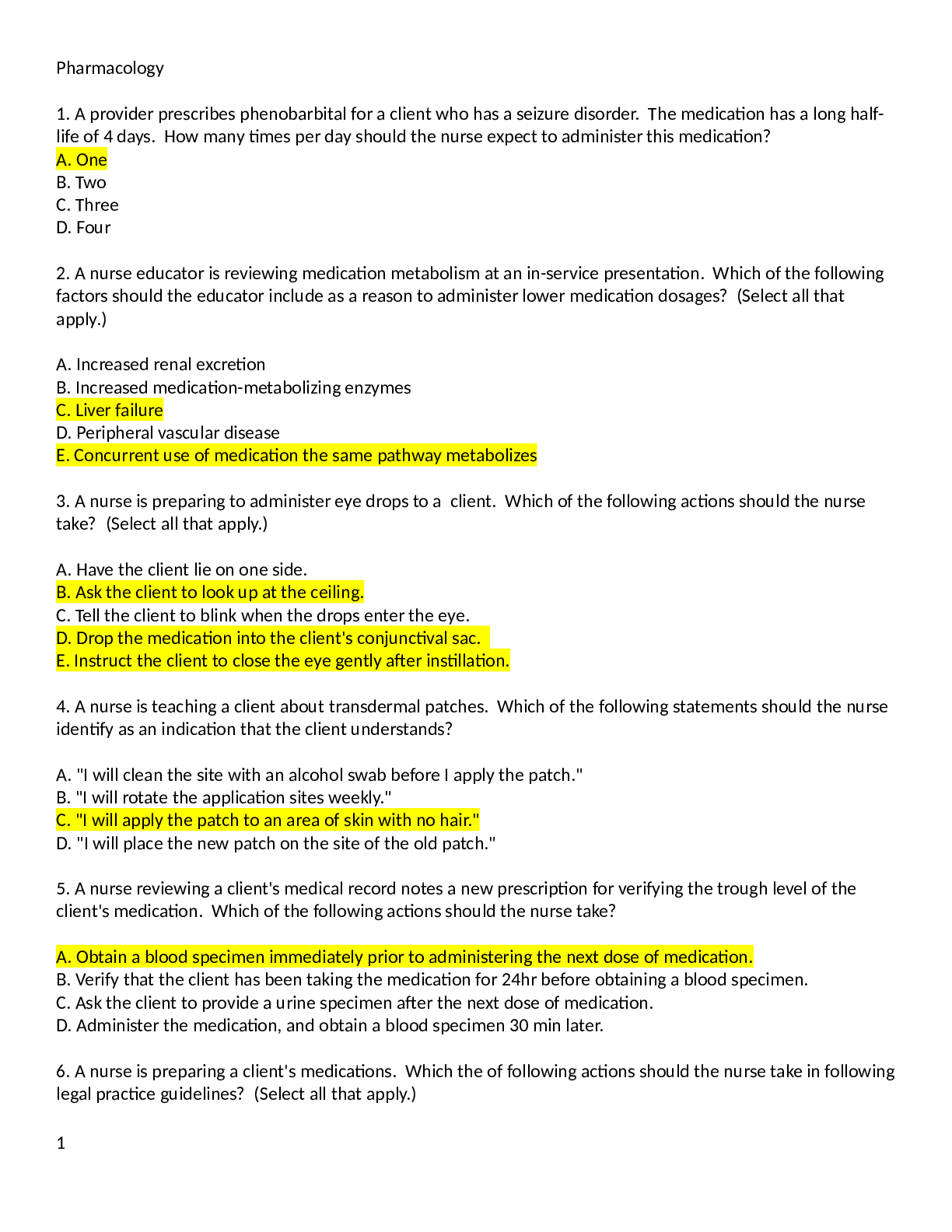
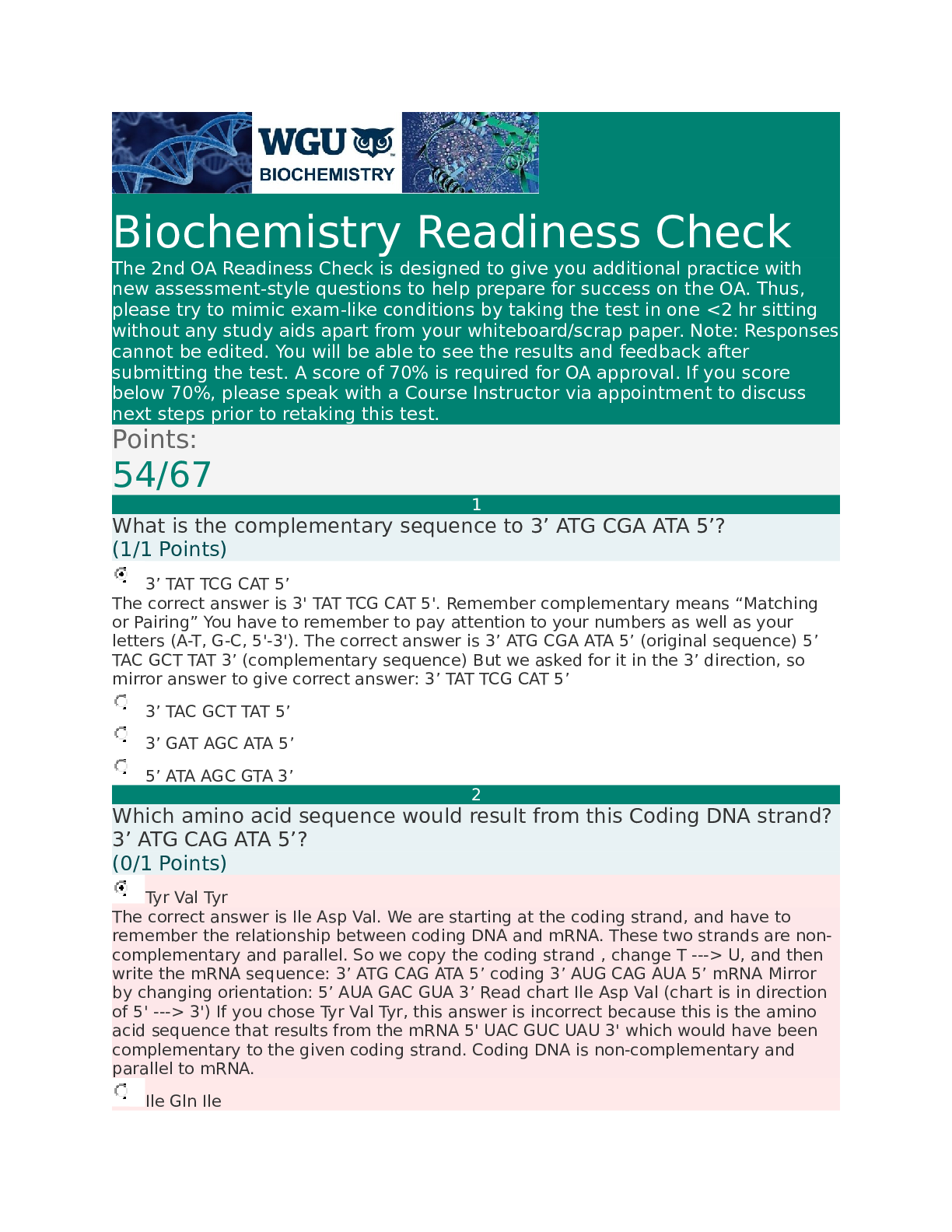
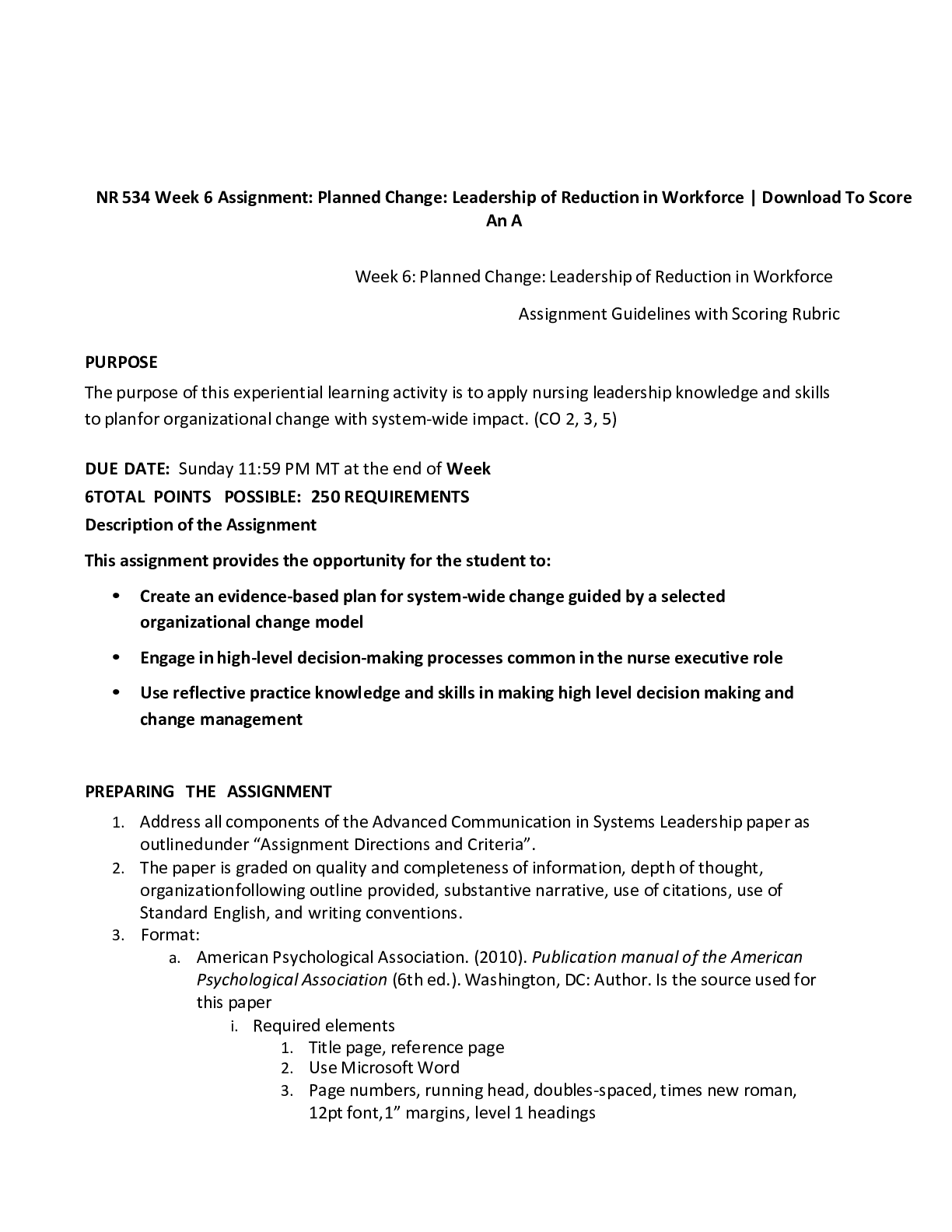
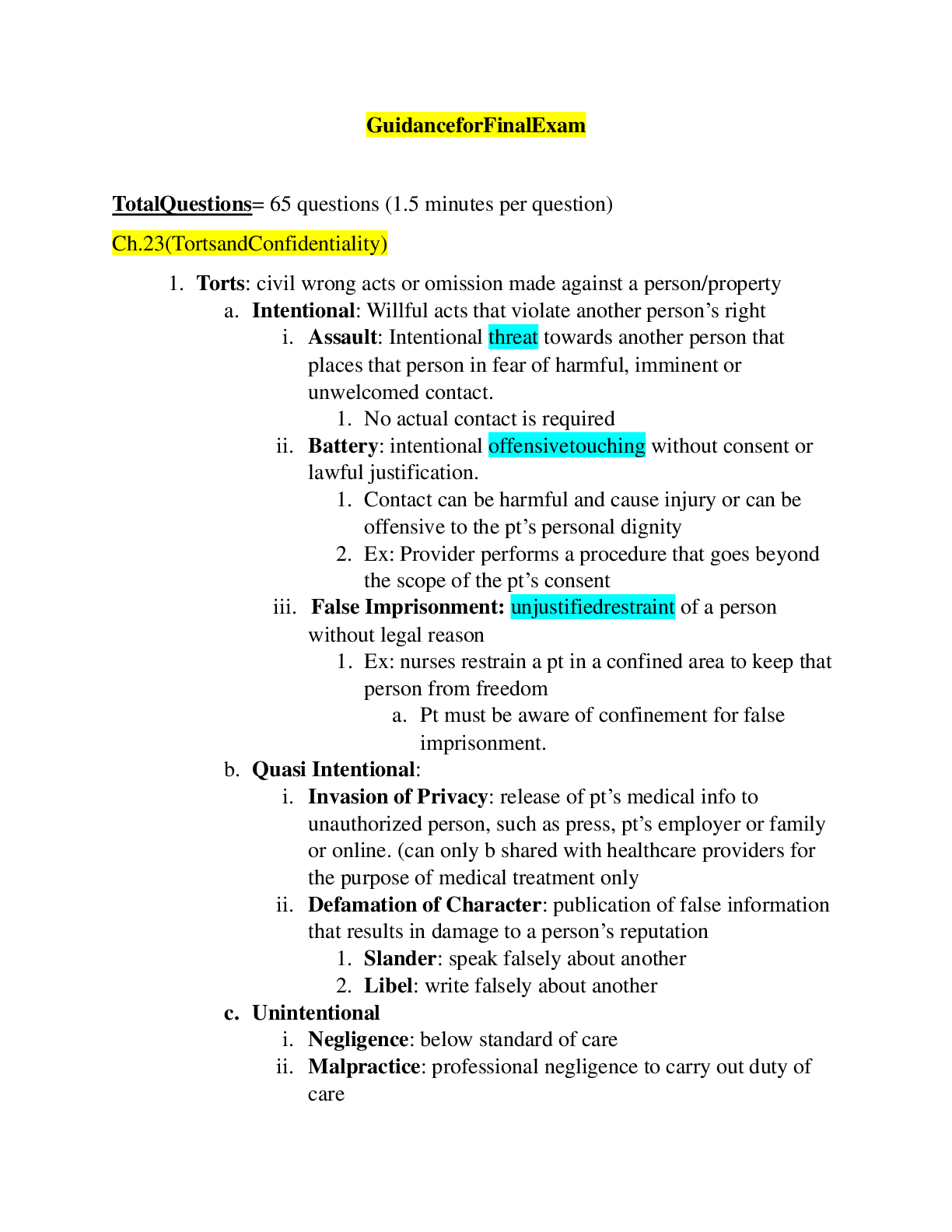


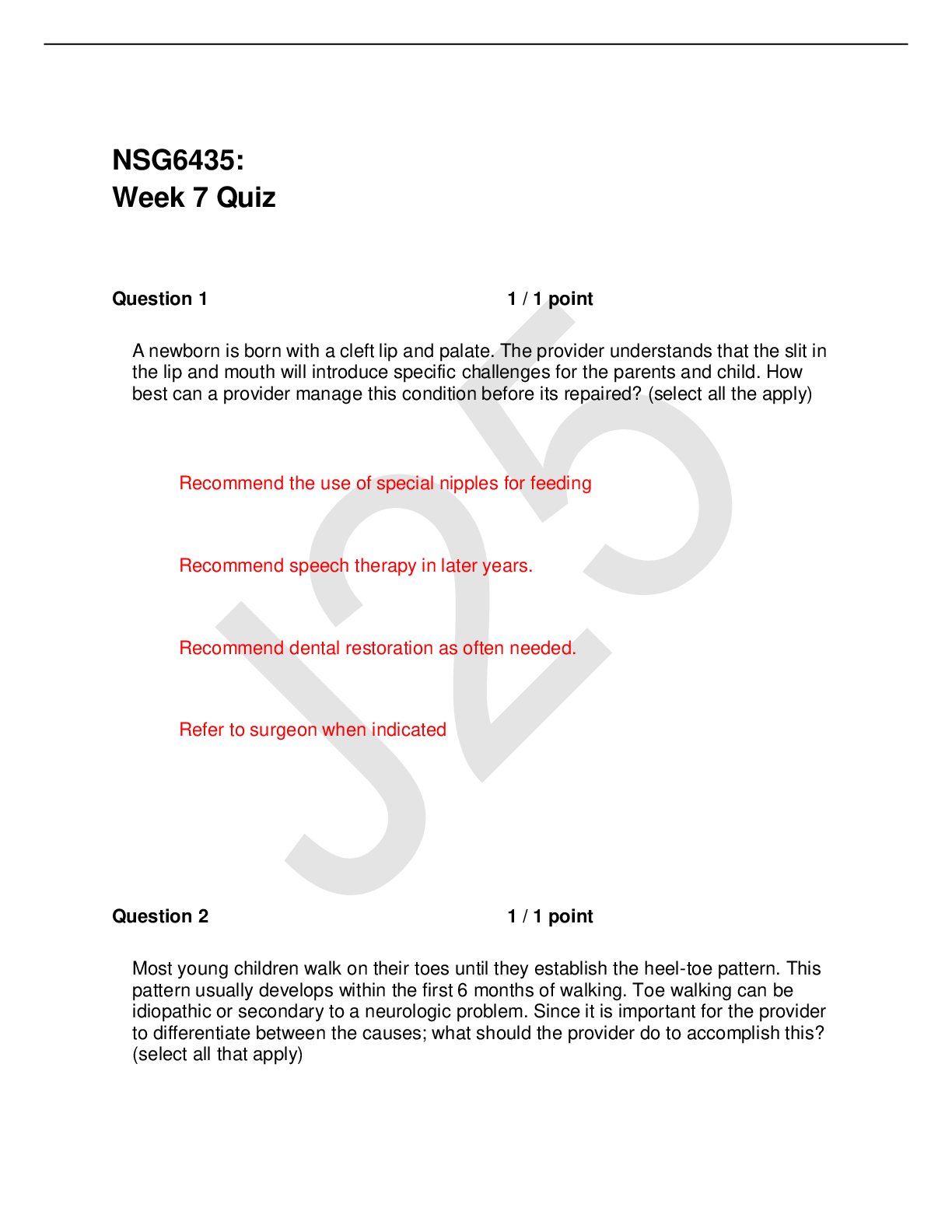


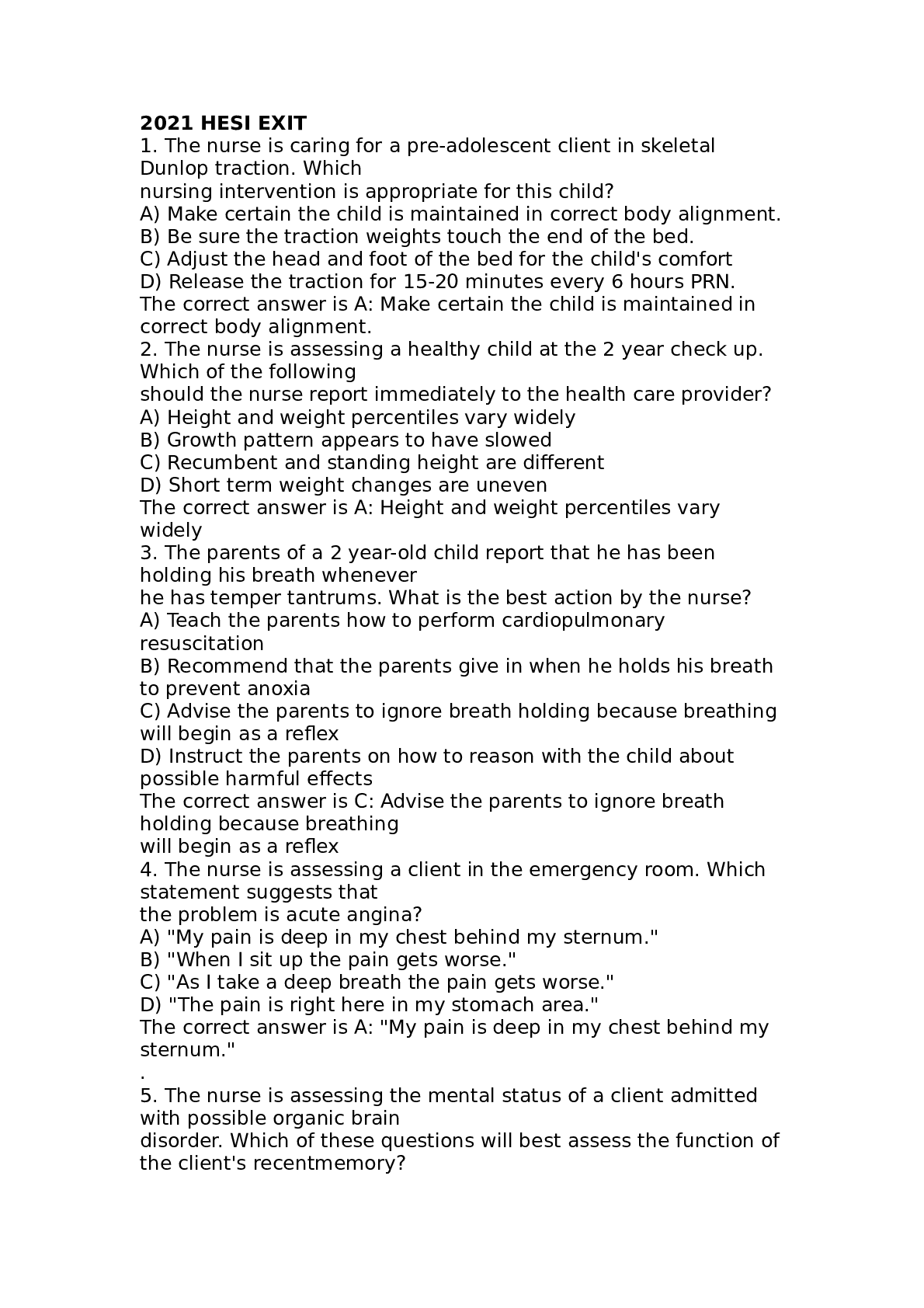
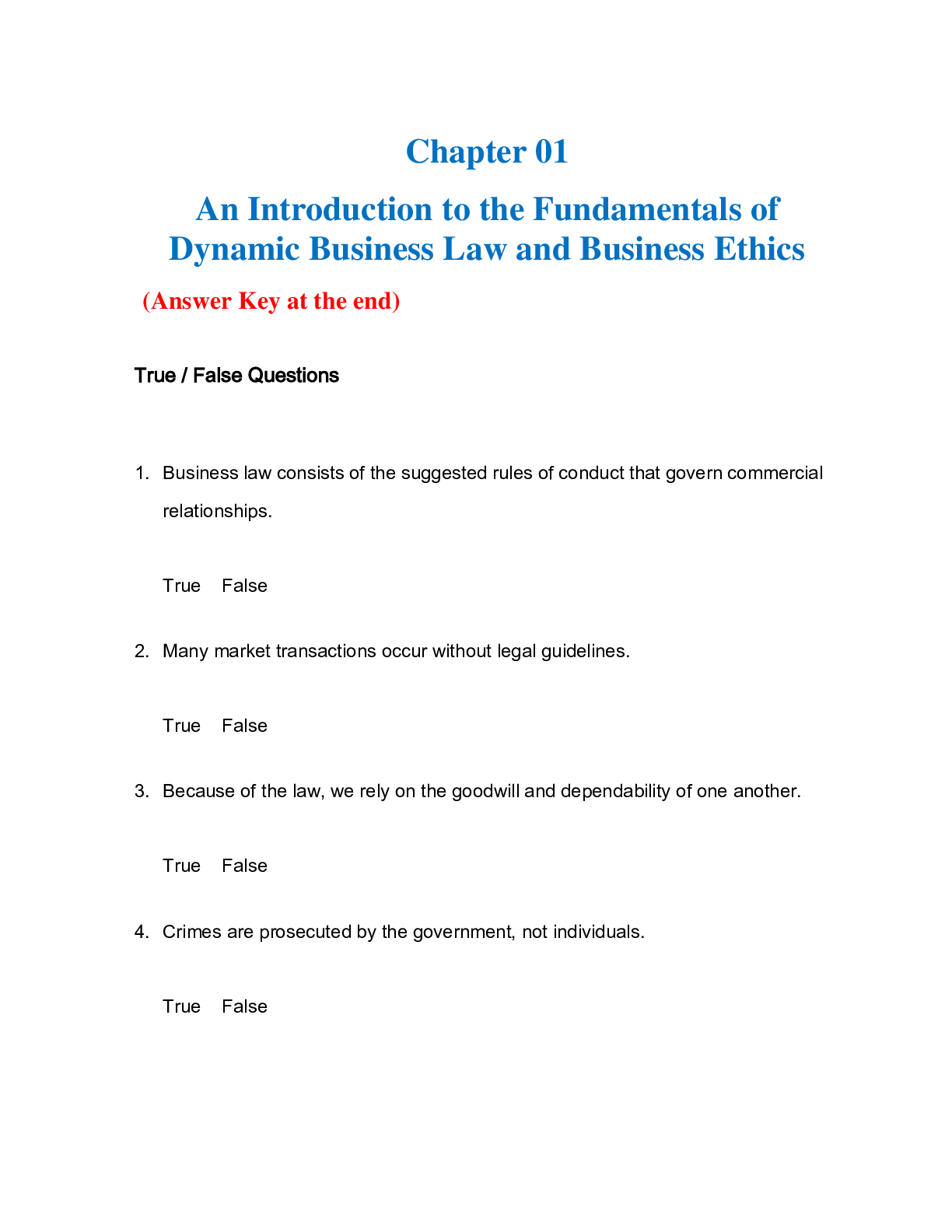
 (1).png)

